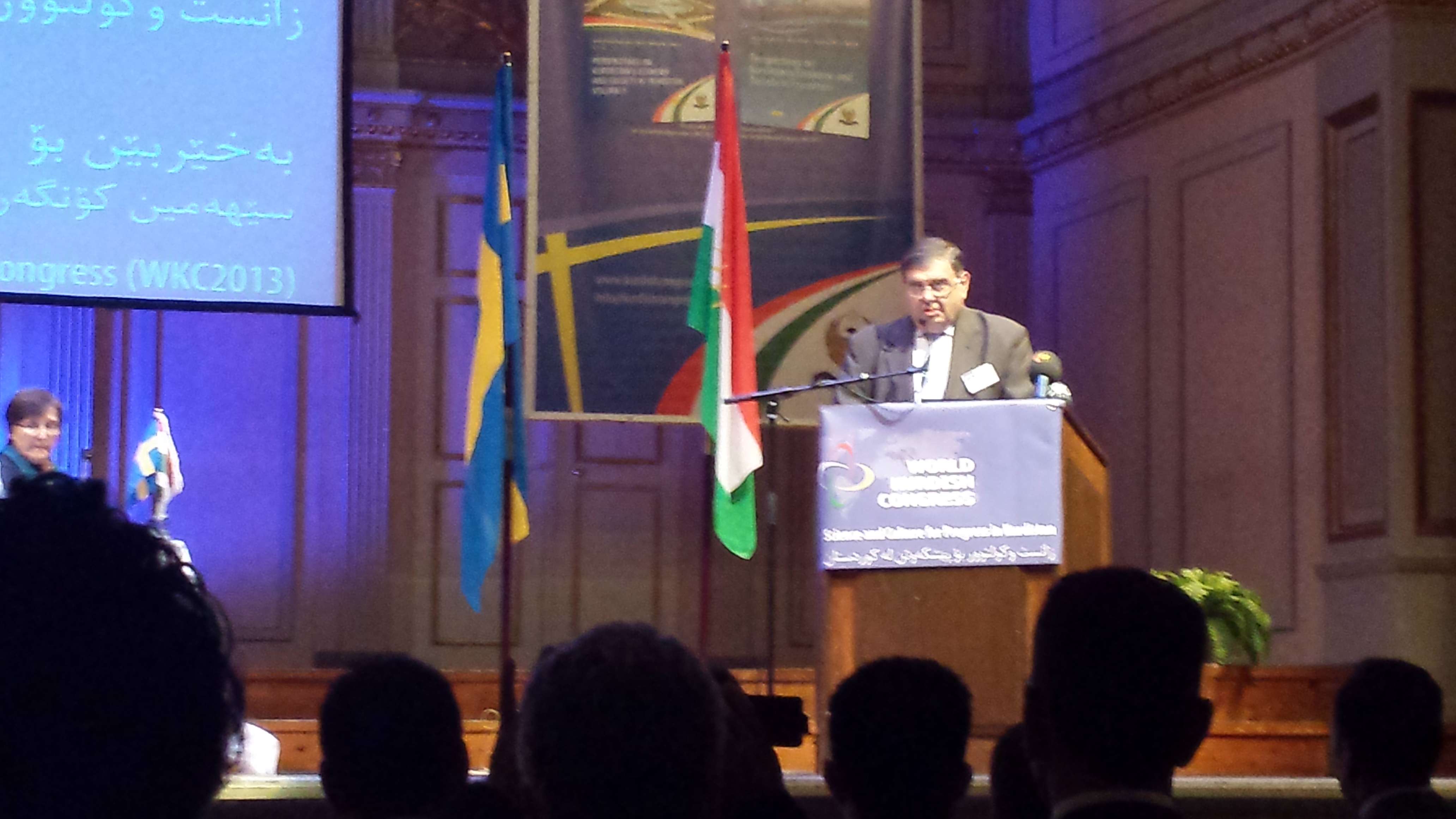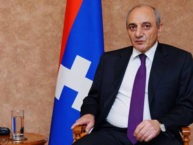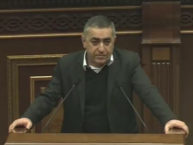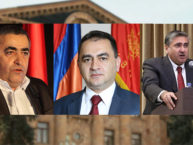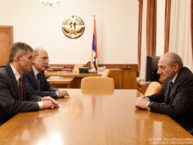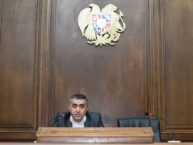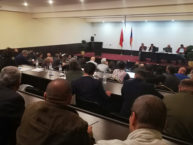Kurdistan Regional Government’s financial, scientific and cultural issues were touched at the 3rd World Kurdish Scientific Congress which was convened on October 11-13, 2013, in Stockholm, Sweden. During the three-day event experts in the aforementioned fields delivered presentations and reports and laid the foundations for future plans. The main objectives of the Congress were the strengthening of the existence and role of Kurdistan within the framework of the continuously developing, progressive and contemporary global society and at the meantime providing peace and prosperity for the Middle East region.
Welcoming speeches were given by the Head of the Department of Foreign Relations of the Kurdistan Regional Government, Falah Mustafa Bakir, Swedish MP, Fredrik Malm, WKC President, Alan Dilani and other prominent figures such as Canadian MP Jim Karygiannis.
The European Armenian Federation for Justice and Democracy (EAFJD) was invited to take part in the panel of the first session called “Lessons Learned from a Successful Diaspora” and address the Congress with a keynote speech. EAFJD President, Kaspar Karampetian referred to the causes that formed the Armenian Diaspora as well as to its present state of affairs. Karampetian emphasized on the respect of the political rights of the Kurdish minority during the 1st Republic of Armenia (1918-1920) such as the election of a Kurdish member of Parliament as well as during the Soviet times when the Kurdish minority could enjoy the benefits of having a radio and a newspaper using their native language.
Following is the speech of EAFJD President, Kaspar Karampetian.
The Experience of the Armenian Diaspora
KASPAR KARAMPETIAN
President of European Armenian Federation, Brussels-Armenia
Session 1: Lessons Learned from a Successful Diaspora
Honorable ministers,
Dear friends, distinguished guests, ladies and gentlemen,
On behalf of the European Armenian Federation for Justice and Democracy I bring warm greetings to the 3rd Scientific World Kurdish Congress. We thank the organizers of this Congress for the invitation and the opportunity to address the honorable participants.
Just as the not so distant past of the Armenian and Kurdish peoples is closely related, so are the present and the future of our two peoples. Destined to share a common geography, dialogue and discussions between Armenians and Kurds, even when at times characterized more as disagreements than agreements, are surely preferable than the conflict and carnage which have at times marred our common history.
The European Armenian Federation for Justice and Democracy, of which I am the President, was founded in 2000 in Brussels, as the interlocutor within the institutions of the European Union, as well as the Council of Europe, representing the European citizens of Armenian origin and coordinating the activities of the Armenian National Committees (ANCs) in Europe.
The European Armenian Federation advocates for the rights of the Armenian population (in the Nagorno Karabakh Republic, the Samtskhe-Javakheti region in Georgia, and in Turkey including the historically Armenian territories), and denounces the hostile attitude towards these populations (blockade against Armenia, Genocide denial, threat of war, violation of the rights of the Armenians, etc.). Also, the EAFJD assists the citizens of the Republic of Armenia in their democratization process of the country.
The Armenian Diaspora is a historical phenomenon almost as old as the history of Armenians in their cradle of civilization in Asia Minor. In the fourth century, Armenian communities already existed outside of Greater Armenia. Armenian communities emerged in the Sassanid and Persian empires, and also to defend eastern and northern borders of the Byzantine Empire. In order to populate depopulated regions of Byzantium, Armenians were relocated to those regions. Although an Armenian Diaspora existed during Antiquity and the Middle Ages, it grew in size due to emigration from the Ottoman Empire and the Transcaucasia in the Russia Empire. In short, throughout history Armenians have established communities in many regions throughout the world, from imperial Rome to Christian Jerusalem, from India to Bavaria to England. Hence it should not surprise anyone to know that the Armenian cultural centres during several centuries preceding the 19th century were cities like Venice, Amsterdam, Constantinople, Tiflis, Isfahan, Madras, Kolkata, Saint Petersburg.
It is due to this global reach and influence that the Armenian National Awakening in the 19th century, which actually began in the Diaspora, reached the Armenian towns and villages in the Ottoman and Romanov empires. Indeed, the Armenians were awakening to a new national consciousness that brought forth a fighting spirit. This change was produced by political, social and economic forces that were at work both in foreign lands and in the Armenian divided homeland. The more active and enlightened Armenians began organized action for self-protection, for human rights and eventually for political independence.
With this background, the modern Armenian Diaspora was formed largely after the World War I as a result of the Armenian Genocide of 1915-1923 committed by the Ottoman Empire and Turkey. It is in this period of state planned and organized extermination attempt, that the darkest pages of Armenian and Kurdish common history were written. As a result of the genocide, Armenians were forced to flee to different parts of the world and created new Armenian communities far from their native land. Today around 3 million Armenians live in Armenia and around 7 million Armenians in the Diaspora.
However, while the Genocide was still going on, another historical event had a tremendous effect on the course of Armenian history. In May of 1918, when the disintegration of the Russian empire was followed by the fragmentation of the Trans Caucasus, and following decisive battles near Yerevan and to further north-east, the Armenian National Council, announced the creation of the Republic of Armenia. The creation of the Republic proved to be the single most effective way to save the remnants of the Armenian people and preserve the few historically Armenian districts still free of Turkish occupation. In the Republic of Armenia of 1918–1920 the Kurds received political rights: a Kurdish representative was elected to the Armenian parliament, some Kurds became officers of Armenian army and organized Kurdish volunteer units.
Although the independence of the Republic was short lived, less than three years, and the fact that an Armenian state structure continued to exist— albeit as part of the Soviet Union —, the Armenian existence was transformed. With a significant portion of the surviving Armenians living abroad, the quasi-state of Armenia became both a rallying point for those who believed and strived for an independent Armenia and an apparatus which helped the revival of Armenians both physically and culturally.
Following the years after the Genocide when the Armenians who survived, found shelters in other countries, the first preoccupation of the leaders was to take all the necessary steps to insure that Armenians be able to safeguard their national identity. They founded schools, churches and cultural centers. The main objective was for the first decades, that the Armenians of Diaspora, could establish themselves in the countries they were living, assuring decent living standards, thus allowing them to provide to the younger generation, the possibility to get educated, understand the complexity of the problems that we were facing and be able in the future to take initiatives, in pursuing the struggle for the rights of our nation.
And indeed, after the Second World War, during the decades of the 50s and 60s, we already had a generation which was not facing any more, in general, problems of survival, was somehow educated and was ready to take over the responsibility of the pursuance of the legitimate national claims. It was in 1965, on the 50th anniversary of the Genocide, that for the first time the Armenians of all over the world, declared their decision to pursue by all political means the recognition of the Genocide by the International Community and most of all from Turkey. That period the biggest political party of the Armenian Diaspora ARF Dashnaktsutyun, formed the Armenian National Committees (known as ANCs), in all the countries where Armenian communities existed.
The ANCs with planned and persistent work, in the next decades, broke the wall of silence imposed to Armenians regarding the Genocide. Many countries, among them almost half of the countries of EU, recognized the Genocide, as well as the European Parliament, the Mercosur and other international bodies. Today, Turkey still denies a crime against the humanity, that no one in the world has any doubts about it. We will continue our struggle to oblige Turkey to recognize the genocide and bear the responsibility of the reparations to the Armenian nation.
The Armenian Diaspora is playing a crucial rolein in the political and economic evolution of today’s independent Armenia. From the early 90’s the Armenian Diaspora has organized many times special events to gather amounts and help to the amelioration of the infrastructure of Armenia.
Armenian Republic is today under blockade by Turkey and Azerbaijan, because of the conflict of Nagorno Karabakh5 where the people living there decided by a referendum the basic value of self determination, to create an independent country, the Nagorno Karabakh Republic. Thus, the role of the Armenian Diaspora grows every day, and from 2008 the Armenian Republic has the Ministry of Diaspora, which handles directly in every way the relations with the Armenian Diaspora, promoting and solving all the problems. It is proven so for that it was a successful initiative and of course when it will accumulate more experience and means it will play even greater role between the motherland and the Diaspora.
It was in the Soviet Armenian quasi-state that the Kurds enjoyed substantial state-sponsored cultural support. It is here that the Kurds of the Soviet Union first began writing Kurdish in the Armenian alphabet in the 1920s, followed by Latin in 1927, then Cyrillic in 1945, and now in both Cyrillic and Latin. The Kurds in Armenia established a Kurdish radio broadcast from Yerevan and the first Kurdish newspaper Riya Teze. The Kurds of Armenia were the first to have access to media such as radio, education and press in their native tongue. Armenian radio station Denge Erivan (The Voice of Yerevan) broadcast in Kurdish for one hour a day, drawing an audience of ethnic Kurds from across the border in Turkish occupied Western Armenia.
It is also worth reminding ourselves that in the 1920s and early 1930s, the most active and positive page in the history of Armenian-Kurdish relations, was written prior to and during the actual Kurdish rebellions of Dersim and especially Mt. Ararat. The Armenian Revolutionary Federation-Dashnaktsutyun was instrumental in providing much needed aid to the Kurdish national movement. It provided the moral support that Kurdish warriors needed in their battles against the Turkish armies. It was within the confines of this moral support that the ARF-Dashnaktsutyun provided critical help to the Kurdish Revolution and its leading organization, Hoyboun. This was achieved through the channels of the Second Socialist International.
The ARF-Dashnaktsutyun did all this with only one goal in mind: to make the world understand that in the far away mountain of Ararat a people was fighting for freedom. It was besieged by regular army battalions that were shelling not only freedom fighters but even families, children, and elderly people. The ARF-Dashnaktsutyun delivered a historical background of the Kurdish people to the General Assembly of the Socialist International concentrating particularly on the events of 1920-1930. It emphasized the deportation and relocation policies deployed by the Kemalist government that aimed at the Turkification of the Kurds and their uprooting from their ancestral, national, and historical homeland.
Today, the Middle East is at a crossroads; the artificially set borders are under pressure to give in to the realities on the ground. The Kurdish people and the Kurdistan Region are at the core of these prospective changes. The Republic of Armenia and Armenians in the region and around the world have a vested interest in these changes and are able to influence them. A new Armenian-Kurdish global alliance — based on mutual respect and consideration of the interests of both peoples — would surely be not only mutually beneficial, but would also help the development of a more tolerant, progressive, inclusive Middle East. We should avoid our past mistakes; we should not allow others to sow enmity between us.
Once again, I thank you for this invitation and wish the 3rd Scientific World Kurdish Congress success in its deliberations.

